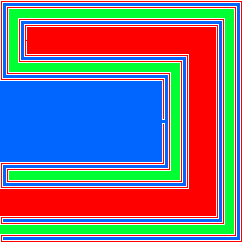In mathematics, any vector space has a corresponding dual vector space consisting of all linear forms on together with the vector space structure of pointwise addition and scalar multiplication by constants.
In mathematical analysis and in probability theory, a σ-algebra on a set X is a nonempty collection Σ of subsets of X closed under complement, countable unions, and countable intersections. The ordered pair is called a measurable space.
Distributions, also known as Schwartz distributions or generalized functions, are objects that generalize the classical notion of functions in mathematical analysis. Distributions make it possible to differentiate functions whose derivatives do not exist in the classical sense. In particular, any locally integrable function has a distributional derivative.
In mathematics, a quadric or quadric surface (quadric hypersurface in higher dimensions), is a generalization of conic sections (ellipses, parabolas, and hyperbolas). It is a hypersurface (of dimension D) in a (D + 1)-dimensional space, and it is defined as the zero set of an irreducible polynomial of degree two in D + 1 variables; for example, D = 1 in the case of conic sections. When the defining polynomial is not absolutely irreducible, the zero set is generally not considered a quadric, although it is often called a degenerate quadric or a reducible quadric.
In the mathematical field of real analysis, the monotone convergence theorem is any of a number of related theorems proving the good convergence behaviour of monotonic sequences, i.e. sequences that are non-increasing, or non-decreasing. In its simplest form, it says that a non-decreasing bounded-above sequence of real numbers converges to its smallest upper bound, its supremum. Likewise, a non-increasing bounded-below sequence converges to its largest lower bound, its infimum. In particular, infinite sums of non-negative numbers converge to the supremum of the partial sums if and only if the partial sums are bounded.
In combinatorics, a branch of mathematics, a matroid is a structure that abstracts and generalizes the notion of linear independence in vector spaces. There are many equivalent ways to define a matroid axiomatically, the most significant being in terms of: independent sets; bases or circuits; rank functions; closure operators; and closed sets or flats. In the language of partially ordered sets, a finite simple matroid is equivalent to a geometric lattice.
Vapnik–Chervonenkis theory was developed during 1960–1990 by Vladimir Vapnik and Alexey Chervonenkis. The theory is a form of computational learning theory, which attempts to explain the learning process from a statistical point of view.
In functional analysis and related areas of mathematics, locally convex topological vector spaces (LCTVS) or locally convex spaces are examples of topological vector spaces (TVS) that generalize normed spaces. They can be defined as topological vector spaces whose topology is generated by translations of balanced, absorbent, convex sets. Alternatively they can be defined as a vector space with a family of seminorms, and a topology can be defined in terms of that family. Although in general such spaces are not necessarily normable, the existence of a convex local base for the zero vector is strong enough for the Hahn–Banach theorem to hold, yielding a sufficiently rich theory of continuous linear functionals.

In mathematics, an antimatroid is a formal system that describes processes in which a set is built up by including elements one at a time, and in which an element, once available for inclusion, remains available until it is included. Antimatroids are commonly axiomatized in two equivalent ways, either as a set system modeling the possible states of such a process, or as a formal language modeling the different sequences in which elements may be included. Dilworth (1940) was the first to study antimatroids, using yet another axiomatization based on lattice theory, and they have been frequently rediscovered in other contexts.
In mathematics, planar algebras first appeared in the work of Vaughan Jones on the standard invariant of a II1 subfactor. They also provide an appropriate algebraic framework for many knot invariants (in particular the Jones polynomial), and have been used in describing the properties of Khovanov homology with respect to tangle composition. Any subfactor planar algebra provides a family of unitary representations of Thompson groups. Any finite group (and quantum generalization) can be encoded as a planar algebra.
In functional analysis and related areas of mathematics, a set in a topological vector space is called bounded or von Neumann bounded, if every neighborhood of the zero vector can be inflated to include the set. A set that is not bounded is called unbounded.
In general topology, the pseudo-arc is the simplest nondegenerate hereditarily indecomposable continuum. The pseudo-arc is an arc-like homogeneous continuum, and played a central role in the classification of homogeneous planar continua. R. H. Bing proved that, in a certain well-defined sense, most continua in Rn, n ≥ 2, are homeomorphic to the pseudo-arc.
In the theory of probability, the Glivenko–Cantelli theorem, named after Valery Ivanovich Glivenko and Francesco Paolo Cantelli, describes the asymptotic behaviour of the empirical distribution function as the number of independent and identically distributed observations grows. Specifically, the empirical distribution function converges uniformly to the true distribution function almost surely.
In mathematics, a random compact set is essentially a compact set-valued random variable. Random compact sets are useful in the study of attractors for random dynamical systems.
In mathematics, uniform integrability is an important concept in real analysis, functional analysis and measure theory, and plays a vital role in the theory of martingales.
In mathematics, the Vitali covering lemma is a combinatorial and geometric result commonly used in measure theory of Euclidean spaces. This lemma is an intermediate step, of independent interest, in the proof of the Vitali covering theorem. The covering theorem is credited to the Italian mathematician Giuseppe Vitali. The theorem states that it is possible to cover, up to a Lebesgue-negligible set, a given subset E of Rd by a disjoint family extracted from a Vitali covering of E.
In mathematics, a cardinal function is a function that returns cardinal numbers.
In the mathematical field of point-set topology, a continuum is a nonempty compact connected metric space, or, less frequently, a compact connected Hausdorff space. Continuum theory is the branch of topology devoted to the study of continua.
In algebra, the Nichols algebra of a braided vector space is a braided Hopf algebra which is denoted by and named after the mathematician Warren Nichols. It takes the role of quantum Borel part of a pointed Hopf algebra such as a quantum groups and their well known finite-dimensional truncations. Nichols algebras can immediately be used to write down new such quantum groups by using the Radford biproduct.
This is a glossary of algebraic geometry.




































